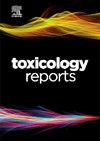幸存的氰化物中毒:一个病例报告强调早期使用解毒剂的作用
Q1 Environmental Science
引用次数: 0
摘要
大剂量口服氰化物摄入后存活的情况非常罕见,如果不治疗,通常会在一小时内死亡。然而,立即治疗可以挽救生命。我们描述一个病人谁完全恢复后及时干预。他被送到急诊室时已经失去知觉,皮肤发红,格拉斯哥昏迷等级为3级,怀疑是故意服用一种未知的白色结晶粉末。他很快心脏骤停。血气分析显示严重的代谢性酸中毒,高乳酸,高铁血红蛋白轻微升高。疑似氰化物中毒患者给予羟钴胺素(5 g静脉注射2剂)和硫代硫酸钠(12.5 g静脉注射)。此后,自然循环又恢复了。病人在加护病房插管并注射镇静剂4天。拔管后,他被转到普通病房。磁共振成像扫描显示无缺氧后或毒性损伤。在14天的住院治疗中,他完全康复了。在药物学实验室用红外光谱法鉴定出白色粉末,证实了氰化物的存在。随后,病人承认摄入氰化钾。他从他工作的化学实验室获得了氰化钾。本文章由计算机程序翻译,如有差异,请以英文原文为准。
Surviving cyanide poisoning: A case report highlighting the role of early antidote use
Survival after high-dose oral cyanide ingestion is rare, and when untreated cases often result in death within an hour. Immediate treatment however, can be lifesaving. We describe a patient who fully recovered after prompt intervention. He arrived at the emergency department unconscious, with red skin and a Glasgow Coma Scale of 3 and was suspected of an intentional intoxication with an unknown white crystalline powder. He rapidly suffered a cardiac arrest. Blood gas analysis showed severe metabolic acidosis, high lactate, and slightly elevated methemoglobin. In suspect of cyanide poisoning, hydroxocobalamin (2 doses of 5 g intravenous) and sodium thiosulfate (12.5 g intravenous) were administered. Thereafter spontaneous circulation returned. The patient was intubated and sedated in the intensive care unit for four days. After extubation, he was transferred to a general ward. A magnetic resonance imaging scan showed no post-anoxic or toxic damage. During his 14-day stay, he fully recovered. The white powder was identified in the pharmaceutical laboratory by infrared spectrometry, confirming the presence of cyanide. Subsequently, the patient admitted to ingesting potassium cyanide. He obtained the potassium cyanide from his workplace, a chemical laboratory.
求助全文
通过发布文献求助,成功后即可免费获取论文全文。
去求助
来源期刊

Toxicology Reports
Environmental Science-Health, Toxicology and Mutagenesis
CiteScore
7.60
自引率
0.00%
发文量
228
审稿时长
11 weeks
 求助内容:
求助内容: 应助结果提醒方式:
应助结果提醒方式:


